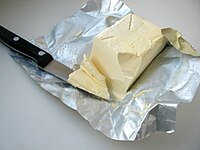
Photo from wikipedia
Background/objectives There are limited data on the association between dairy products consumption and nonalcoholic fatty liver disease (NAFLD). This study was conducted to evaluate the association between total intake of… Click to show full abstract
Background/objectives There are limited data on the association between dairy products consumption and nonalcoholic fatty liver disease (NAFLD). This study was conducted to evaluate the association between total intake of different dairy products and fatty liver index (FLI), a marker of subclinical fatty liver. Methods A total of 7,540 adults were included in this population-based cohort study. Dairy products consumption was evaluated by a validated interview questionnaire for food intake frequency. The FLI was calculated using the standard formula. Liver enzyme levels, lipid profiles, glycemic profiles and demographic characteristics were recorded for all participants. Univariate and multiple logistic regression models were used to respectively assess the mean percentage difference of mean FLI and odds ratios (ORs) for subclinical NAFLD across quantiles of dairy consumption. Results The mean age of all participants was 48.81 ± 9.631 years. FLI measurements for men and women were 26.71 ± 23.39 and 39.99 ± 26.64 respectively, which was significantly higher in women (P < 0.05). Multiple logistic regression analysis demonstrated that the amount of milk consumption was an independent preventive predictor of FLI (OR = 0.96; 95% CI: 0.94–0.99), conversely, it did not predict higher levels of liver enzymes. In term of cheese intake, participants in the third tertile of cheese intake had significantly lower FLI than lower tertiles (P = 0.01). However, there wasn't any significant association between cheese intake and the odds of FLI in the multivariate model (P > 0.05). We didn't find any significant association between yogurt consumption and NAFLD indicators (P > 0.05). Conclusion Higher milk consumption was inversely associated with FLI. However, there wasn't any significant association between other types of dairy products and NAFLD indicators.
Journal Title: Frontiers in Nutrition
Year Published: 2022
Link to full text (if available)
Share on Social Media: Sign Up to like & get
recommendations!